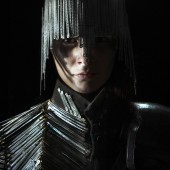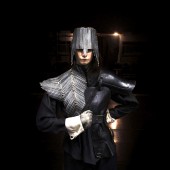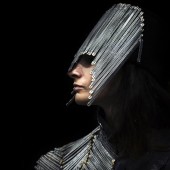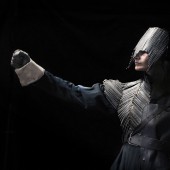
| THE AWARD |
| CATEGORIES |
| REGISTRATION |
| SUBMIT YOUR WORK |
| ENTRY INSTRUCTIONS |
| TERMS & CONDITIONS |
| PUBLICATIONS |
| DATES & FEES |
| METHODOLOGY |
| CONTACT |
| WINNERS |
| PRESS ROOM |
| GET INVOLVED |
| DESIGN PRIZE |
| DESIGN STORE |
| THE AWARD | JURY | CATEGORIES | REGISTRATION | PRESS | WINNERS | PUBLICATIONS | ENTRY INSTRUCTIONS |
The Armor Costume For a Character by Samantha Chijona Garcia |
Home > Winners > Design #102743 >Interview |
 |
|
FS: What is the main principle, idea and inspiration behind your design?
SC: The text of Shakespeare's play emphasizes the many faces and the physical problem of the character, his troubles and aspirations, desires and fears, those feelings which accompanied him during all the play, letting him taste the glory and also the death. I wanted to create an armor inspired in that principle, a structure that left him vulnerable while protecting him, reflecting his personality from a modern vision and materials.
FS: What has been your main focus in designing this work? Especially what did you want to achieve?
SC: I was focused on the character presence on stage, the public had to understand that the King is also a human been. That's why I focused on keeping the essence of a classical armor while used modern and recycled materials, especially reflecting pieces to play with the light and leather ones to keep always one half in darkness. The spectator had to be impressed with the Richard III aspect, what he inspired, the fear and the lightness, but they should feel also his vulnerability and human side.
FS: How long did it take you to design this particular concept?
SC: I was working in the theater play for two months, this armor in special takes me one month for all the conceptual work including a selection of materials and tests with them.
FS: Why did you design this particular concept? Was this design commissioned or did you decide to pursuit an inspiration?
SC: This design was commissioned, I worked for a young theater director who wanted to create a modern and different version of this classic Shakespeare play.
FS: Is your design being produced or used by another company, or do you plan to sell or lease the production rights or do you intent to produce your work yourself?
SC: My costume design was a unique piece made by me for a commission for a Shakespeare by the young theater director known as Jazz Martinez Gamboa.
FS: What made you design this particular type of work?
SC: I really love costume design, my career until the time of this work had been mostly related to the film and TV world, so when I was called to be part of the costume team for this play, I was very excited. . I have always considered theater a platform where designers have great freedom and creative power. The play itself, a modernized Shakespeare made by women only, became challenging and allowed me to play with historical and modern elements at the same time and male and female patterns. The King's armor was positioned as one of the most pregnant pieces in the work and I considered creating something different. The lack of resources when working made me consider the search for already used materials and thus the project with which I entered the contest was born.
FS: Where there any other designs and/or designers that helped the influence the design of your work?
SC: Having studied for years structures that we use when dressing and that have protected and distancing ourselves from the real world I choose one of my favorite, the armor. I took advantage of the study of Western and Japanese war pieces and modernized it and used it as inspiration. I always have like references designers who I admire for, like Eiko Ishioka or Michelle Clapton, both always work with overlapping, mixed materials, colors, and textures and created incredible costume designs for a lot of big projects.
FS: What sets this design apart from other similar or resembling concepts?
SC: I think two elements make this design unique, one of them is the materials with which it was created, reused pieces from old corsets and leather leggings that simply appeared in stock and we decided to combine, and the other is such a close relationship that unites the piece to the text, the armor became one more reflection of the personality and traumas of Ricardo III, discovering his physical problem and emphasizing the darkness and light within the man and the King who coexist inside him.
FS: Which design tools did you use when you were working on this project?
SC: In the first part of the creative process when I was doing research and collecting references, I used Pinterest and Behance, then I went to a second phase of making sketches and tests with fabrics and colors, drawing a lot. Most of the tools I used this time come from an artisan process because the materials I had on hand (corset whales and riding gaiters) lacked flexibility and had had another function, it was impossible to assess their possibilities digital, it was time to test, assemble and sew by hand.
FS: What is the most unique aspect of your design?
SC: This armor is made with fully recycled materials, mixes metallic corset nerves referring to the classic western armor, topped by a butcher's chainmail glove that evokes the bloodthirsty of the character and leather leggings overlapping layers denoting the various faces assumed by the character during the plot. It has a modern vision in terms of fabric, overlapping, and weaving of pieces, It is unique the materials mix I used and how I organized them, letting them a new function. The play created between the lightness and darkness due to the metal and leather pieces creates also a beautiful contrast emphasizing the beauty of the design itself. It is Beautiful but also impressive and innovative.This armor, made with fully recycled materials, mixes metallic corset nerves referring to the classic western armor, topped by a butcher's chainmail glove that evokes the bloodthirsty of the character with leather leggings overlapping layers denoting the various faces assumed by the character during the plot. From a modernist vision in terms of fabric, overlapping and weaving of pieces the structure refers to the vulnerability of the King and the man who lives at the same time in Richard III.
FS: Who did you collaborate with for this design? Did you work with people with technical / specialized skills?
SC: For this project which included all the theater play costume, I worked with a great designer who was my professor, Vladimir Cuenca, he helped me to develop the first ideas and after when I had the design and I began to make tests my assistant Maria Gabriela Sanchez help me during the sewing and assembling process.
FS: Is your design influenced by data or analytical research in any way? What kind of research did you conduct for making this design?
SC: My research flew over two essential aspects, the historical and the technical. After having studied for years Western and Japanese armors, the challenge of creating one was wonderful. I made a deep analysis of different ways of assembly used in the antique armors, the leather ones from the Samurái culture, and the metal ones from the western. I had to do several fittings to make the armor fit like one only piece and let the actor move inside. I had to solve how I should use and modify the historical engineering structures in those garments with the modern materials I had in hand and also make tests with the corset bones and the leather pieces to mix, due to their predetermined shape. The result was a very visual and modern armor that keeps its basic function, protection while talks about innovation and recycling.
FS: What are some of the challenges you faced during the design/realization of your concept?
SC: Two fundamental elements became challenges during the process of preparing and making the costumes for this work: lack of resources and lack of time. Ricardo III is a complex and extensive work with many characters, working in Cuba and with a national budget, dressing everyone became a challenge. We were clear that clothing sewing should be limited to what was essential and therefore we would search warehouses and stock pieces to combine and create interesting outfits. With this premise, we found in a wardrobe store a box of old leather leggings and corset bones in disuse and we decided to give prominence to those magnificent pieces turning them into The armor. On the other hand, we only had two months to prepare the entire wardrobe, age it, test it and adjust it to the 16 actresses we worked with, until hours before the premiere we were finalizing details and varying elements. An exhausting but rewarding job that I still remember like a challenging one.
FS: How did you decide to submit your design to an international design competition?
SC: I had uploaded the photos taken to the armor to my professional profiles only to have a work sample in my digital portfolio, but one day I received an email that encouraged me to meet the A Design Award and participate. By entering their page I noted the huge contest and the many categories they had so I decided to join and try. I understand the designers work for an audience, not for us, so, the contest allowed me to reach many more people and could help me to make my work more international so I was encouraged, and here I am, happy with this incredible award.
FS: What did you learn or how did you improve yourself during the designing of this work?
SC: The work process for this design taught me the theatrical language, the scenic movement, and the importance and relationship of both with the costumes. I also learned the role of costumes as a central element, pregnant, fundamental, spectacular in a work, its ability to impress the public. A surprise that I found was the thousands of variants and possibilities that old materials give you when it comes to modernity, it is incredible that in most cases if you use creative thinking, the classic elements can totally lose their function and become a completely new piece.
FS: Thank you for providing us with this opportunity to interview you.
A' Design Award and Competitions grants rights to press members and bloggers to use parts of this interview. This interview is provided as it is; DesignPRWire and A' Design Award and Competitions cannot be held responsible for the answers given by participating designers.
| SOCIAL |
| + Add to Likes / Favorites | Send to My Email | Comment | View Press-Release |





